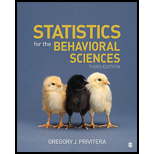
Concept explainers
1.
Find the Chi-square test for independence at 0.05 significance level.
Check whether to retain or reject the null hypothesis test by using the chi-square test for independence.
1.
Answer to Problem 23CAP
The value of test statistic is 4.855.
The decision is to retain the null hypothesis.
The noise level and exam grades during an exam are independent.
Explanation of Solution
Calculation:
The given information is that, a study was conducted by the tests of loudness of noise during an exam (low, medium, high) and exam grades (pass, fail). The summarized table is,
| Noise level | Totals | ||||
| Low | Medium | High | |||
| Exam | Pass | 20 | 18 | 8 | 46 |
| Fail | 8 | 6 | 10 | 24 | |
| Totals | 28 | 24 | 18 | ||
Table 1
The formula for total participants is,
In the formula,
The formula for expected frequency is,
In the formula, N denotes the total participants.
Test statistic:
The formula for chi-square test statistic is,
In the formula,
The formula for degrees of freedom for chi-square independence test is,
In the formula,
Null hypothesis:
Alternative hypothesis:
Expected frequency:
Substitute the corresponding values of roe totals, column totals and total frequencies for each level of categorical variable in the expected frequency formula.
| Noise level | Totals | ||||
| Low | Medium | High | |||
| Exam | Pass | 46 | |||
| Fail | 24 | ||||
| Totals | 28 | 24 | 18 | ||
Table 2
Substitute,
Critical value:
The given significance level is
From the Appendix C: Table C.7 Critical values for Chi-square:
- Locate the value 2 in the degrees of freedom (df) column.
- Locate the 0.05 in level of significance row.
- The intersecting value that corresponds to the 2 with level of significance 0.05 is 5.99.
The critical value for
Test statistic value:
Substitute the corresponding values of observed and expected frequencies for each level of categorical variable in the test statistic formula.
Hence, the value of test statistic is 4.855.
Conclusion:
The test statistic value is 4.855.
The critical value is 5.99.
The test statistic value is less than the critical value.
The null hypothesis is retained.
The noise level and exam grades during an exam are independent.
2.
Find the effect size using Cramer’s V.
2.
Answer to Problem 23CAP
The effect size using Cramer’s V is 0.26.
Explanation of Solution
Calculation:
The test statistic is 4.855, and value of N is 70.
The formula for effect size using Cramer’s V is,
In the formula,
For
The smaller degrees of freedom are 1.
Substitute,
Hence, effect size using Cramer’s V is 0.26.
Want to see more full solutions like this?
Chapter 17 Solutions
Statistics for the Behavioral Sciences
 Glencoe Algebra 1, Student Edition, 9780079039897...AlgebraISBN:9780079039897Author:CarterPublisher:McGraw Hill
Glencoe Algebra 1, Student Edition, 9780079039897...AlgebraISBN:9780079039897Author:CarterPublisher:McGraw Hill Calculus For The Life SciencesCalculusISBN:9780321964038Author:GREENWELL, Raymond N., RITCHEY, Nathan P., Lial, Margaret L.Publisher:Pearson Addison Wesley,
Calculus For The Life SciencesCalculusISBN:9780321964038Author:GREENWELL, Raymond N., RITCHEY, Nathan P., Lial, Margaret L.Publisher:Pearson Addison Wesley,

